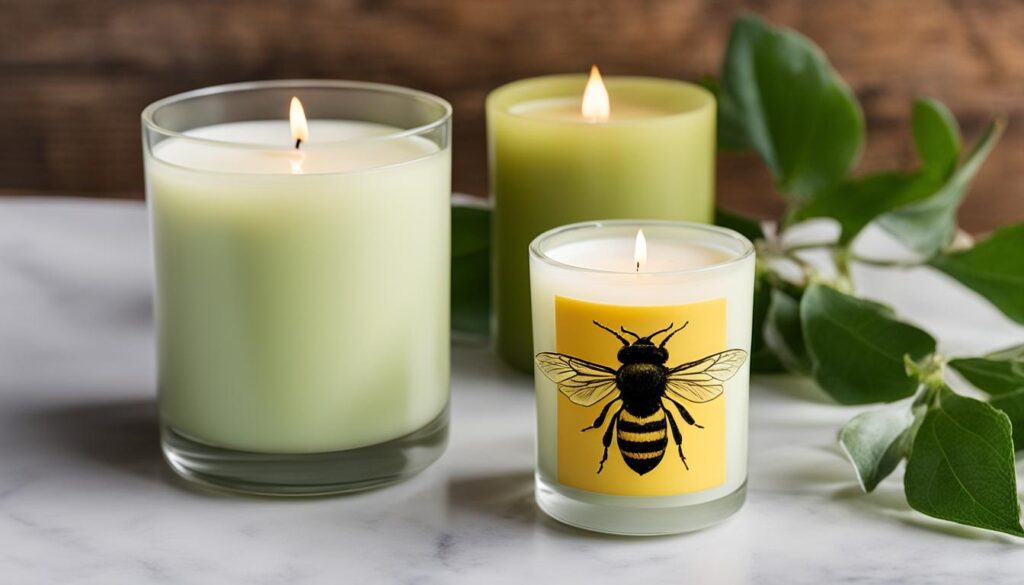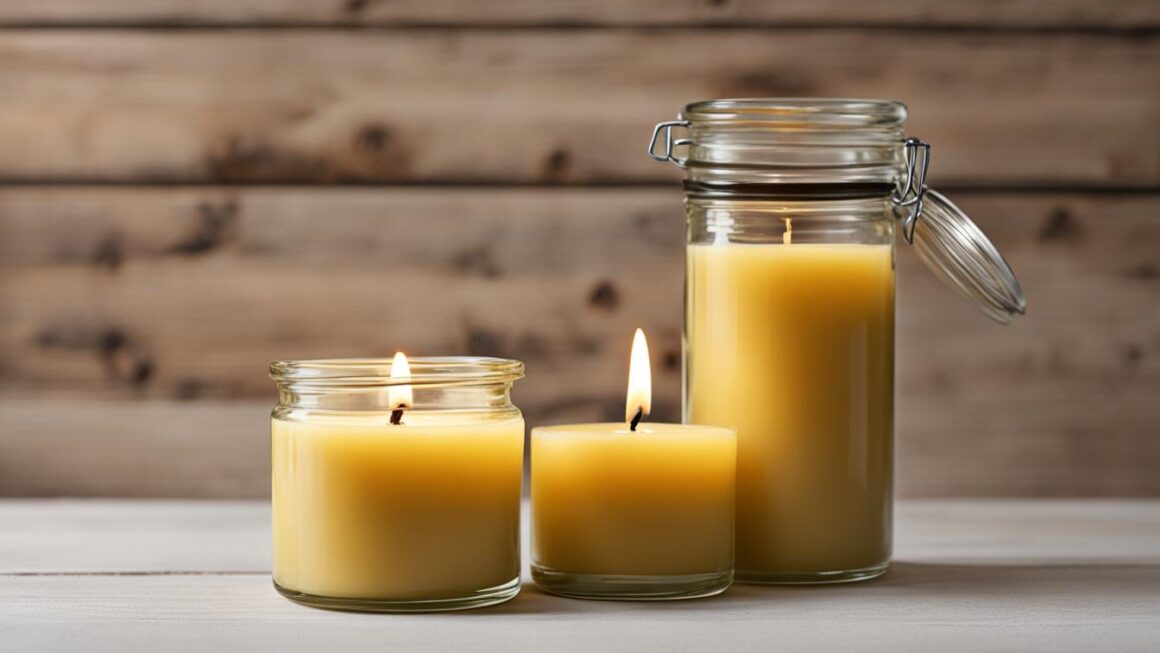When considering the type of candles to use, the choice between soy and beeswax candles can be a tough one. Both options have their own advantages and unique qualities. In this article, we will explore the benefits of soy candles and the advantages of beeswax candles, helping you make an informed decision about which is the better choice for you.
Key Takeaways:
- Soy candles offer affordability and a wide range of color options.
- Beeswax candles have a higher burn temperature and provide air purification benefits.
- Both soy and beeswax candles are eco-friendly and natural candle options.
- Soy candles are vegan-friendly, while beeswax candles are not suitable for vegans.
- Consider your priorities and preferences when choosing between soy and beeswax candles.
Cost Comparison
When it comes to choosing between soy and beeswax candles, cost is an important factor to consider. In general, soy wax candles are more affordable compared to beeswax candles. The lower cost of soy candles can be attributed to the additional expenses involved in beeswax production, such as the feed required for bees. For every pound of beeswax produced, bees need to consume 6-8 pounds of honey. This makes beeswax candles more expensive to produce and, consequently, more expensive to purchase.
In terms of price difference, the exact cost may vary depending on factors such as brand, size, and quality. However, on average, soy wax candles tend to be more budget-friendly compared to beeswax candles.
| Soy Wax Candles | Beeswax Candles | |
|---|---|---|
| Cost | Lower | Higher |
| Price Difference | Varies | Varies |
Table: Cost Comparison of Soy Wax Candles vs Beeswax Candles
In summary, if you are looking for a more cost-effective option, soy candles are the way to go. They provide a wallet-friendly alternative without compromising on quality or eco-friendliness. However, if budget is not a major concern and you value the unique qualities of beeswax, such as its sweet scent and air purification benefits, beeswax candles may still be worth the investment.
Burn Temperature
One important factor to consider when choosing between soy and beeswax candles is their burn temperature. Beeswax candles have a higher burn temperature compared to soy candles, making them more heat resistant and long-lasting in high-temperature conditions. The higher burn temperature of beeswax candles allows them to withstand hotter environments without melting or deforming. This makes them a preferred choice for those who need candles that can withstand extreme heat.
Soy candles, on the other hand, may have a lower burn temperature and may not perform as well in extremely hot environments. They are best suited for moderate temperature conditions. If you frequently use candles in rooms with high heat, such as near fireplaces or outdoor spaces, beeswax candles are the better option due to their better heat resistance and longer burn time.
Table: Comparison of Burn Temperature
| Burn Temperature | Heat Resistance | Burn Time | |
|---|---|---|---|
| Beeswax Candles | Higher | Better | Longer |
| Soy Candles | Lower | Not as good | Shorter |
Table: Comparison of burn temperature, heat resistance, and burn time between beeswax candles and soy candles.
This table clearly shows the differences in burn temperature, heat resistance, and burn time between beeswax candles and soy candles. It is important to consider these factors when choosing the right candles for your needs and preferences.
Vegan-Friendly Option
For individuals who follow a vegan lifestyle or prefer to support vegan-friendly products, soy candles are the better choice. Made from soybeans, soy wax is derived entirely from plant sources, making it a vegan-friendly option. It does not involve the use of any animal products or byproducts in its production process. This makes soy candles a suitable choice for those who prioritize ethical and sustainable alternatives.
Soy candles for vegans offer the same benefits as other soy candles, including a clean and eco-friendly burn. They produce minimal soot and are biodegradable, ensuring a reduced impact on the environment. Additionally, soy wax can be easily dyed to achieve various colors, allowing for customization and versatility in aesthetics. These vegan candles are a great way to create a cozy and inviting atmosphere while staying true to your vegan values.
In contrast, while beeswax candles may have their own unique advantages, they are not considered vegan due to the involvement of bees in their production. Beeswax is a substance produced by bees as a structural component of their hives. Therefore, individuals looking for vegan candles should opt for soy candles over beeswax candles to align with their ethical choices.
Environmental Impact
When choosing between soy and beeswax candles, considering the environmental impact of each option is crucial. Both soy candles and beeswax candles are widely regarded as eco-friendly choices that offer sustainable alternatives to traditional paraffin candles. However, it is important to examine the specific environmental impacts of each type of candle.
Soy wax, derived from soybeans, has gained popularity due to its renewable and biodegradable properties. It produces significantly less soot when burned compared to paraffin candles, resulting in cleaner air quality in your home. Soy candles are also non-carcinogenic and non-hazardous, making them a safer choice for both your health and the environment.
On the other hand, beeswax candles have their own unique environmental benefits. Beeswax is a byproduct of bees’ pollination and honey production process. Choosing beeswax candles supports beekeeping and the preservation of bee populations, which are crucial for pollination and maintaining biodiversity. Beeswax is also biodegradable and, similar to soy wax, does not release harmful toxins when burned.
| Soy Candles | Beeswax Candles | |
|---|---|---|
| Renewability | Derived from soybeans | Byproduct of bees’ pollination and honey production process |
| Soot Production | Produces less soot compared to paraffin candles | Produces minimal soot |
| Biodegradable | Yes | Yes |
| Preservation of Bee Populations | N/A | Supports beekeeping and bee populations |
While both soy and beeswax candles offer eco-friendly choices, it is worth noting that the environmental impact of soy wax can be influenced by factors such as the use of pesticides and fertilizers in soybean farming. Opting for organic soy candles can help mitigate potential environmental concerns.
In summary, both soy candles and beeswax candles provide sustainable and environmentally conscious options for candle lovers. Consider your personal values, including support for bee populations and the use of organic ingredients, when making your decision.
Scent Throw: A Comparison Between Soy Candles and Beeswax Candles
When it comes to creating a warm and inviting atmosphere in your home, scent plays a crucial role. Both soy candles and beeswax candles are popular choices for their ability to fill a room with fragrance. Let’s compare the scent throw of these two types of candles and see how they perform.
Scent Throw of Soy Candles
Soy candles are known for their strong and long-lasting fragrance. The natural properties of soy wax allow it to hold a higher concentration of scent compared to other candle materials. This means that when you light a soy candle, it will release a powerful and delightful aroma that can fill a room quickly.
Soy wax also has excellent cold scent throw, which means that even when the candle is not lit, it still emits a pleasant fragrance. This makes soy candles a great choice if you want your home to always smell inviting, even when the candle is not in use.
Scent Throw of Beeswax Candles
Beeswax candles, on the other hand, are typically known for their natural and subtle scent. While beeswax itself has a slight honey aroma, it is not as potent as the fragrance found in soy candles. However, beeswax candles have their own unique charm, as they emit a warm and cozy ambiance that enhances the overall atmosphere.
One advantage of beeswax candles is that they purify the air by releasing negative ions. These ions help to neutralize pollutants and allergens, creating a cleaner and healthier environment. While this may not directly affect the scent throw, it adds an additional benefit to consider when choosing between soy and beeswax candles.
| Soy Candles | Beeswax Candles | |
|---|---|---|
| Scent Throw | Strong and long-lasting | Natural and subtle |
| Cold Scent Throw | Excellent | N/A |
| Ambiance | N/A | Warm and cozy |
| Air Purification | N/A | Yes |
Ultimately, the choice between soy candles and beeswax candles when it comes to scent throw depends on personal preference. If you prefer a strong and long-lasting fragrance, soy candles are the way to go. On the other hand, if you enjoy a more subtle and natural scent with the added benefit of air purification, beeswax candles offer a unique experience.
Remember to consider other factors such as cost, burn time, and eco-friendliness when making your final decision. Both soy and beeswax candles have their own merits, allowing you to find the perfect candle to create a delightful ambiance in your home.

Aesthetics
When it comes to the aesthetics of candles, both soy and beeswax options offer distinct qualities. Soy wax provides more flexibility in terms of color options, allowing for customization and creativity. It can be easily dyed to achieve various colors, enhancing the overall visual appeal of the candles. Whether you prefer vibrant and bold hues or soft pastel shades, soy candles can be tailored to match your personal style and decor. The versatility of soy wax colors makes it a popular choice for those who enjoy experimenting with different looks.
On the other hand, beeswax candles usually have a natural white-brown color. This natural hue adds a touch of warmth and elegance to any space. The subtle and earthy tones of beeswax candles can complement a rustic or minimalistic aesthetic. Some individuals appreciate the simplicity and authenticity of the natural color, finding it soothing and calming. If you prefer a more organic and understated look, beeswax candles can provide a serene ambiance in your home.
In summary, soy wax offers more options for customizing candle colors, allowing for a wide range of possibilities to match your personal style. Beeswax candles, on the other hand, have a natural and timeless beauty that can enhance the overall ambiance of a space.
Table: Aesthetics Comparison
| Aspect | Soy Candles | Beeswax Candles |
|---|---|---|
| Color Options | Wide range of customizable colors | Natural white-brown color |
| Visual Appeal | Customizable and vibrant | Natural and understated |
| Aesthetic Style | Flexible and creative | Rustic and minimalistic |
Table: A comparison of the aesthetics of soy and beeswax candles.
Allergies and Health Considerations
When it comes to choosing candles, considering allergies and health is important. Both soy candles and beeswax candles are generally considered hypoallergenic, making them suitable for individuals with environmental allergies and sensitivities. Unlike paraffin candles, which can produce soot and potentially aggravate allergies, soy and beeswax candles burn cleaner and have a lower risk of triggering allergic reactions.
Soy candles, in particular, are often recommended for individuals with allergies. They are made from soy wax, which is derived from soybeans and does not contain any common allergens such as animal products or artificial fragrances. This makes soy candles a safer option for those with specific sensitivities.
On the other hand, beeswax candles offer potential air purification benefits. While there is limited scientific evidence to support this claim, some believe that beeswax candles release negative ions when burned, which can help neutralize pollutants in the air. This makes beeswax candles a popular choice for individuals concerned about air quality in their homes.
“Both soy and beeswax candles provide hypoallergenic options, promoting cleaner air and reducing the risk of triggering allergies.”

In conclusion, both soy and beeswax candles can be favorable choices for individuals with allergies and health considerations. Soy candles are vegan-friendly and do not contain common allergens, while beeswax candles offer potential air purification benefits. Ultimately, the choice between soy and beeswax candles depends on individual preferences and needs.
Burn Time
One important factor to consider when choosing between soy candles and beeswax candles is the burn time. Beeswax candles generally have a longer burn time compared to soy candles. Due to its higher melt temperature, beeswax lasts longer when poured as a candle. On average, 100g of poured beeswax can burn for approximately 29 hours, while soy candles of the same weight may burn for around 18 hours. This longer burn time makes beeswax candles a preferred choice for those looking for longer-lasting candles.
In addition to their longer burn time, beeswax candles also tend to produce a brighter, warmer glow compared to soy candles. This can create a cozy and inviting ambiance in any space. The longer-lasting burn time and the warm glow of beeswax candles make them a popular choice for special occasions, romantic settings, or simply when you want to enjoy the flickering light for an extended period.
However, it’s important to note that the burn time of candles can vary depending on factors such as the size of the candle, the wick used, and how the candle is cared for. It’s always recommended to follow the manufacturer’s instructions for optimal burn time and safety.
Conclusion
In the ongoing debate between soy and beeswax candles, both options offer their own unique advantages. Soy candles are a more affordable choice, suitable for those on a budget. They are also vegan-friendly and provide a wide range of color options for customization. Additionally, soy candles have a good scent throw and are considered eco-friendly.
On the other hand, beeswax candles boast a higher burn temperature, making them more heat resistant and ideal for hot environments. They also offer potential air purification benefits, releasing negative ions into the air. Furthermore, beeswax candles have a longer burn time, providing a longer-lasting candle experience.
Ultimately, the decision between soy and beeswax candles depends on individual preferences and needs. Whether affordability, sustainability, specific features, or aesthetics take precedence, both soy and beeswax candles are excellent choices for natural and eco-friendly candle options. So, explore your options and enjoy the warm, comforting glow of your chosen candle!
FAQ
Are soy candles cheaper than beeswax candles?
Yes, soy candles are generally cheaper than beeswax candles due to the additional costs associated with beeswax production.
Which type of candle has a higher burn temperature?
Beeswax candles have a higher burn temperature compared to soy candles.
Are soy candles vegan-friendly?
Yes, soy candles are vegan-friendly as they are derived from soybeans and do not involve any animal products.
Are soy and beeswax candles eco-friendly?
Yes, both soy and beeswax candles are considered eco-friendly options.
Which type of candle has a stronger scent throw?
Soy candles are known for their strong scent throw, especially when paired with fragrance or essential oils.
Can you customize the color of soy candles?
Yes, soy candles offer more flexibility in terms of color options and can be easily dyed to achieve various colors.
Are soy and beeswax candles suitable for individuals with allergies?
Yes, both soy and beeswax candles are generally hypoallergenic and suitable for individuals with allergies and sensitivities.
Which type of candle has a longer burn time?
Beeswax candles generally have a longer burn time compared to soy candles.
Which type of candle is better overall?
The choice between soy and beeswax candles ultimately depends on individual preferences and needs. Both types of candles have their own unique advantages.




